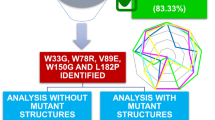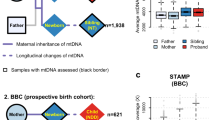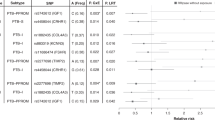Abstract
Background:
Preterm delivery (PTD) is the leading cause of neonatal morbidity and mortality. Epidemiologic studies indicate recurrence of PTD is maternally inherited, creating a strong possibility that mitochondrial variants contribute to its etiology. This study examines the association between mitochondrial genotypes and PTD and related outcomes.
Methods:
This study combined, through meta-analysis, two case–control, genome-wide association studies: one from the Danish National Birth Cohort Study and one from the Norwegian Mother and Child Cohort Study (MoBa) conducted by the Norwegian Institute of Public Health. The outcomes of PTD (≤36 wk), very PTD (≤32 wk), and preterm prelabor rupture of membranes (PPROM) were examined. A total of 135 individual single-nucleotide polymorphism (SNP) associations were tested using the combined genome from mothers and neonates (case vs. control) in each population and then pooled via meta-analysis.
Results:
After meta-analysis, there were four SNPs for the outcome of PTD below P ≤ 0.10 and two below P ≤ 0.05. For the additional outcomes of very PTD and PPROM, there were three and four SNPs, respectively, below P ≤ 0.10.
Conclusion:
Given the number of tests, no single SNP reached study-wide significance (P = 0.0006). Our study does not support the hypothesis that mitochondrial genetics contributes to the maternal transmission of PTD and related outcomes.
Similar content being viewed by others
Log in or create a free account to read this content
Gain free access to this article, as well as selected content from this journal and more on nature.com
or
References
Callaghan WM, MacDorman MF, Rasmussen SA, Qin C, Lackritz EM . The contribution of preterm birth to infant mortality rates in the United States. Pediatrics 2006;118:1566–73.
Lawn JE, Cousens S, Zupan J; Lancet Neonatal Survival Steering Team. 4 million neonatal deaths: when? Where? Why? Lancet 2005;365:891–900.
Marlow N, Wolke D, Bracewell MA, Samara M; EPICure Study Group. Neurologic and developmental disability at six years of age after extremely preterm birth. N Engl J Med 2005;352:9–19.
Wood NS, Marlow N, Costeloe K, Gibson AT, Wilkinson AR . Neurologic and developmental disability after extremely preterm birth. EPICure Study Group. N Engl J Med 2000;343:378–84.
Martin JA, Hamilton BE, Sutton PD, Ventura SJ, Mathews TJ, Osterman MJ . Births: final data for 2008. Natl Vital Stat Rep 2010;59:1, 3–71.
Cnattingius S . The epidemiology of smoking during pregnancy: smoking prevalence, maternal characteristics, and pregnancy outcomes. Nicotine Tob Res 2004;6:Suppl 2:S125–40.
Thompson JM, Irgens LM, Rasmussen S, Daltveit AK . Secular trends in socio-economic status and the implications for preterm birth. Paediatr Perinat Epidemiol 2006;20:182–7.
Dole N, Savitz DA, Hertz-Picciotto I, Siega-Riz AM, McMahon MJ, Buekens P . Maternal stress and preterm birth. Am J Epidemiol 2003;157:14–24.
Fraser AM, Brockert JE, Ward RH . Association of young maternal age with adverse reproductive outcomes. N Engl J Med 1995;332:1113–7.
Jacobsson B, Ladfors L, Milsom I . Advanced maternal age and adverse perinatal outcome. Obstet Gynecol 2004;104:727–33.
Mercer BM, Goldenberg RL, Moawad AH, et al. The preterm prediction study: effect of gestational age and cause of preterm birth on subsequent obstetric outcome. National Institute of Child Health and Human Development Maternal-Fetal Medicine Units Network. Am J Obstet Gynecol 1999;181(5 Pt 1):1216–21.
Jakobsson M, Gissler M, Sainio S, Paavonen J, Tapper AM . Preterm delivery after surgical treatment for cervical intraepithelial neoplasia. Obstet Gynecol 2007;109(2 Pt 1):309–13.
Edison RJ, Berg K, Remaley A, et al. Adverse birth outcome among mothers with low serum cholesterol. Pediatrics 2007;120:723–33.
Bodnar LM, Catov JM, Simhan HN, Holick MF, Powers RW, Roberts JM . Maternal vitamin D deficiency increases the risk of preeclampsia. J Clin Endocrinol Metab 2007;92:3517–22.
Bodnar LM, Krohn MA, Simhan HN . Maternal vitamin D deficiency is associated with bacterial vaginosis in the first trimester of pregnancy. J Nutr 2009;139:1157–61.
Goldenberg RL, Hauth JC, Andrews WW . Intrauterine infection and preterm delivery. N Engl J Med 2000;342:1500–7.
Romero R, Espinoza J, Gonçalves LF, Kusanovic JP, Friel LA, Nien JK . Inflammation in preterm and term labour and delivery. Semin Fetal Neonatal Med 2006;11:317–26.
Muglia LJ, Katz M . The enigma of spontaneous preterm birth. N Engl J Med 2010;362:529–35.
Kistka ZA, DeFranco EA, Ligthart L, et al. Heritability of parturition timing: an extended twin design analysis. Am J Obstet Gynecol 2008;199:43.e1–5.
Crider KS, Whitehead N, Buus RM . Genetic variation associated with preterm birth: a HuGE review. Genet Med 2005;7:593–604.
Engel SA, Erichsen HC, Savitz DA, Thorp J, Chanock SJ, Olshan AF . Risk of spontaneous preterm birth is associated with common proinflammatory cytokine polymorphisms. Epidemiology 2005;16:469–77.
Menon R, Velez DR, Simhan H, et al. Multilocus interactions at maternal tumor necrosis factor-alpha, tumor necrosis factor receptors, interleukin-6 and interleukin-6 receptor genes predict spontaneous preterm labor in European-American women. Am J Obstet Gynecol 2006;194:1616–24.
Boyd HA, Poulsen G, Wohlfahrt J, Murray JC, Feenstra B, Melbye M . Maternal contributions to preterm delivery. Am J Epidemiol 2009;170:1358–64.
Svensson AC, Sandin S, Cnattingius S, et al. Maternal effects for preterm birth: a genetic epidemiologic study of 630,000 families. Am J Epidemiol 2009;170:1365–72.
Lunde A, Melve KK, Gjessing HK, Skjaerven R, Irgens LM . Genetic and environmental influences on birth weight, birth length, head circumference, and gestational age by use of population-based parent-offspring data. Am J Epidemiol 2007;165:734–41.
Velez DR, Menon R, Simhan H, Fortunato S, Canter JA, Williams SM . Mitochondrial DNA variant A4917G, smoking and spontaneous preterm birth. Mitochondrion 2008;8:130–5.
Goldenberg RL, Culhane JF, Iams JD, Romero R . Epidemiology and causes of preterm birth. Lancet 2008;371:75–84.
Myatt L, Cui X . Oxidative stress in the placenta. Histochem Cell Biol 2004;122:369–82.
Fainaru O, Almog B, Pinchuk I, Kupferminc MJ, Lichtenberg D, Many A . Active labour is associated with increased oxidisibility of serum lipids ex vivo. BJOG 2002;109:938–41.
Mohorovic L . First two months of pregnancy–critical time for preterm delivery and low birthweight caused by adverse effects of coal combustion toxics. Early Hum Dev 2004;80:115–23.
Xu Y, Wang Q, Cook TJ, Knipp GT . Effect of placental fatty acid metabolism and regulation by peroxisome proliferator activated receptor on pregnancy and fetal outcomes. J Pharm Sci 2007;96:2582–606.
Morison IM, Ramsay JP, Spencer HG . A census of mammalian imprinting. Trends Genet 2005;21:457–65.
Cui H, Cruz-Correa M, Giardiello FM, et al. Loss of IGF2 imprinting: a potential marker of colorectal cancer risk. Science 2003;299:1753–5.
Guaschino S, De Seta F, Piccoli M, Maso G, Alberico S . Aetiology of preterm labour: bacterial vaginosis. BJOG 2006;113:Suppl 3:46–51.
Caldji C, Diorio J, Meaney MJ . Variations in maternal care in infancy regulate the development of stress reactivity. Biol Psychiatry 2000;48:1164–74.
Manolio TA, Collins FS, Cox NJ, et al. Finding the missing heritability of complex diseases. Nature 2009;461:747–53.
Olsen J, Melbye M, Olsen SF, et al. The Danish National Birth Cohort–its background, structure and aim. Scand J Public Health 2001;29:300–7.
Magnus P, Irgens LM, Haug K, Nystad W, Skjaerven R, Stoltenberg C; MoBa Study Group. Cohort profile: the Norwegian Mother and Child Cohort Study (MoBa). Int J Epidemiol 2006;35:1146–50.
Rønningen KS, Paltiel L, Meltzer HM, et al. The biobank of the Norwegian Mother and Child Cohort Study: a resource for the next 100 years. Eur J Epidemiol 2006;21:619–25.
Purcell S, Neale B, Todd-Brown K, et al. PLINK: a tool set for whole-genome association and population-based linkage analyses. Am J Hum Genet 2007;81:559–75.
Acknowledgements
We thank Teri Manolio, who was instrumental in the completion of this genome-wide association study. In addition, we thank Hakon K. Gjessing for useful comments and discussion.
Author information
Authors and Affiliations
Consortia
Corresponding author
Rights and permissions
About this article
Cite this article
Alleman, B., Myking, S., Ryckman, K. et al. No observed association for mitochondrial SNPs with preterm delivery and related outcomes. Pediatr Res 72, 539–544 (2012). https://doi.org/10.1038/pr.2012.112
Received:
Accepted:
Published:
Issue date:
DOI: https://doi.org/10.1038/pr.2012.112
This article is cited by
-
Spontaneous preterm birth: the underpinnings in the maternal and fetal genomes
npj Genomic Medicine (2021)
-
Spontaneous preterm birth and single nucleotide gene polymorphisms: a recent update
BMC Genomics (2016)
-
Characterization of mitochondrial haplogroups in a large population-based sample from the United States
Human Genetics (2014)
-
The genomics of preterm birth: from animal models to human studies
Genome Medicine (2013)



